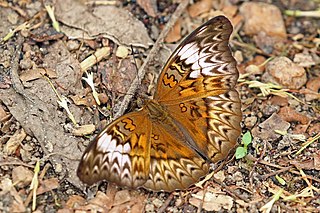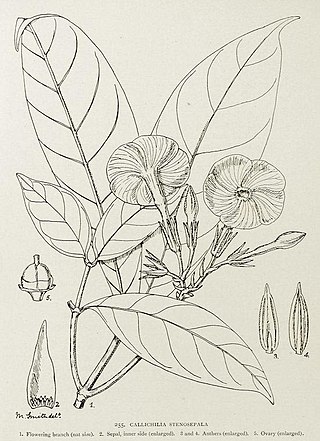
The individual member states of the African Union (AU) coordinate foreign policy through this agency, in addition to conducting their own international relations on a state-by-state basis. The AU represents the interests of African peoples at large in intergovernmental organizations (IGO's); for instance, it is a permanent observer at the United Nations' General Assembly.

Costus is a group of herbaceous perennial plants in the family Costaceae, described by Linnaeus as a genus in 1753. It was formerly known as Hellenia after the Finnish botanist Carl Niclas von Hellens. It is widespread through tropical and subtropical regions of Asia, Africa, and the Americas.

The Guinean forests of West Africa is a biodiversity hotspot designated by Conservation International, which includes the belt of tropical moist broadleaf forests along the coast of West Africa, running from Sierra Leone and Guinea in the west to the Sanaga River of Cameroon in the east. The Dahomey Gap, a region of savanna and dry forest in Togo and Benin, divides the Guinean forests into the Upper Guinean forests and Lower Guinean forests.
Belonophora is a genus of flowering plants in the family Rubiaceae. It is found in Tropical Africa from Senegal east to Sudan and south to Angola. It was described by Joseph Dalton Hooker in 1873.
Calycosiphonia is a genus of flowering plants in the family Rubiaceae. It is native to tropical Africa from Ivory Coast to Sudan to Mozambique.
Marantochloa mildbraedii is a species of plant in the Marantaceae family. It is found in Cameroon, Central African Republic, Equatorial Guinea, Republic of Congo (Brazzaville) and Gabon. Its natural habitat is subtropical or tropical moist lowland forests. It is threatened by habitat loss.

Palisota is a genus of plant in family Commelinaceae, first described in 1828. It is native to sub-Saharan Africa.
Eremospatha is a genus of climbing flowering plants in the palm family found in tropical Africa. These rattans are uncommon in cultivation and poorly understood by taxonomists. Closely related to Laccosperma, they are differentiated by the near complete absence of bracts and bracteoles. The name is from Greek meaning "without a spathe".
Triplochiton is a genus of flowering plants in the family Malvaceae. It is a small genus of trees comprising tall tropical African trees with palmately lobed alternate leaves like those of the maple and being included in the Sterculiaceae subfamily of Malvaceae.
Guaduella is a genus of African plants in the grass family, the only genus in the tribe Guaduelleae. It belongs to the subfamily Puelioideae, one of the early-diverging lineages in the grasses, but used to be included in the bamboos.
- Guaduella densifloraPilg. - Nigeria, Cabinda, Cameroon, Republic of Congo, Gabon, Equatorial Guinea
- Guaduella dichroaCope - Cabinda
- Guaduella humilisClayton - Nigeria, Cameroon
- Guaduella macrostachys(K.Schum.) Pilg. - Ghana, Nigeria, Cameroon, Gabon
- Guaduella marantifoliaFranch. - Cameroon, Republic of Congo, Gabon
- Guaduella oblongaHutch. ex Clayton - Guinea, Sierra Leone, Ivory Coast, Cameroon, Republic of Congo, Gabon, São Tomé, Bioko
Cuviera is a genus of flowering plants in the family Rubiaceae native to tropical Africa. It was originally described by Augustin Pyramus de Candolle in 1807 and is named after the French naturalist Georges Cuvier.

Cymothoe lurida, the lurid glider, is a butterfly in the family Nymphalidae. It is found in Côte d'Ivoire, Ghana, Nigeria, Cameroon, Equatorial Guinea, Gabon, the Republic of the Congo, the Central African Republic, Angola, the Democratic Republic of the Congo, Uganda, Kenya, Tanzania and Zambia. The habitat consists of lowland to submontane forests, including riparian forests.
Craterispermum is a genus of flowering plants in the family Rubiaceae. It contains 16 species that occur in tropical Africa and Seychelles. It is the only genus in the tribe Craterispermeae, of which the divergence time is estimated at 34.8 million years ago.

Callichilia is a genus of plant in the family Apocynaceae, native to tropical Africa.
Motandra is a genus of plant in the family Apocynaceae native to tropical Africa. As of August 2013 the World Checklist of Selected Plant Families recognises 3 species:
- Motandra guineensis(Thonn.) A.DC. - widespread from Liberia to Sudan and south to Angola
- Motandra lujaeDe Wild. & T.Durand - Gabon, Congo, Cabinda, Equatorial Guinea, Zaire
- Motandra poecilophyllaWernham - Gabon, Congo, Equatorial Guinea, Cameroon
- Motandra erlangeriK.Schum = Oncinotis tenuilobaStapf
- Motandra glabrataBaill. = Oncinotis glabrata(Baill.) Stapf ex Hiern
- Motandra viridifloraK.Schum. = Baissea viridiflora(K.Schum.) de Kruif
- Motandra welwitschianaBaill. = Oncinotis hirtaOliv.

Englerophytum is a group of trees in the family Sapotaceae described as a genus in 1914.

Haumania is a genus of plants native to parts of central Africa. As of March 2022, Kew and Plants of the World Online accepts that it only contains 3 recognized species:

Hypselodelphys is a group of plants in the Marantaceae described as a genus in 1950. native to tropical Africa from Liberia to Uganda and south to Angola. It contains 8 recognized species:

Megaphrynium macrostachyum is a species of large plant in the Marantaceae family native to tropical Africa. It grows in moist places and regenerates rapidly after ground disturbance or fire. The long stems have various uses in making cord, baskets and mats, and the large leaves are used for wrapping food, for making utensils and containers, and in herbal medicine.
Gambeya is a genus of flowering plants belonging to the family Sapotaceae.










